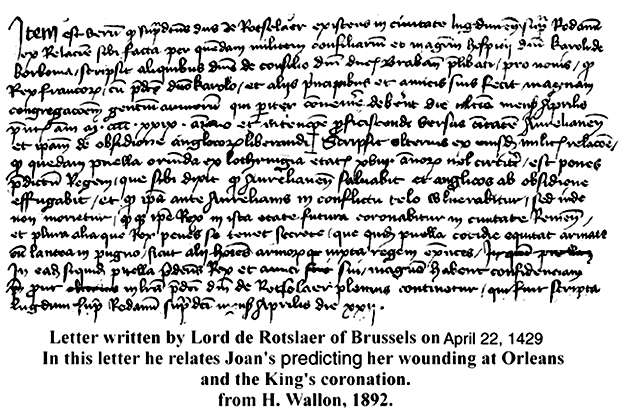
APPENDIX V
GOD'S PROVIDENTIAL CARE OF JOAN
Hundreds of books have been written on the life of Saint Joan. Yet all have mentioned only in passing the four times in her life where she should have died but did not. The authors of the past have not examined closely nor delved into these very unusual and, in my opinion, miraculous occurrences. In this chapter I would like to investigate this subject in a deeper way and show why I believe it was God's providential care that spared her life.

The first of these miraculous circumstances occurred when she received an arrow wound during the assault on the Tourelles. When the historians do mention it, they minimize the wound as being superficial in nature. They arrive at this opinion from a letter written by a Flemish diplomat, Lord de Rotslaer on April 22, 1429, fifteen days before the event. In this letter he states that Joan told King Charles she would be wounded by a shaft, but she would not die of it. Just because Joan said she would not die from the wound does not mean that her life was not saved by God's miraculous intervention!
By profession I was a registered nurse. I have worked in a New York City Hospital Intensive Care Unit and have dealt with trauma cases; because of my medical interest, I want to show that the wound/wounds Joan received would, under normal circumstances, cause major damage to her body and could have been fatal. The fact that she was back in full armor after only a few hours' rest demonstrates that she was protected or healed by God's power rather than the wound only being superficial.
Before I begin my thesis, you need to know certain background information as to what type of projectile caused her wound and in what area of her body it penetrated. First, historians are unsure as to whether Joan's wound was caused by an English Longbow arrow or a bolt from a crossbow, so I will describe both to you. Second, historians are unsure as to which side of Joan's body was injured. For reasons of brevity I will discuss the implications of a severe wound to only her left side of her chest area, but the implications can easily be applied to both sides.
Let us look at the projectile that penetrated her body and the two possible weapons it came from.
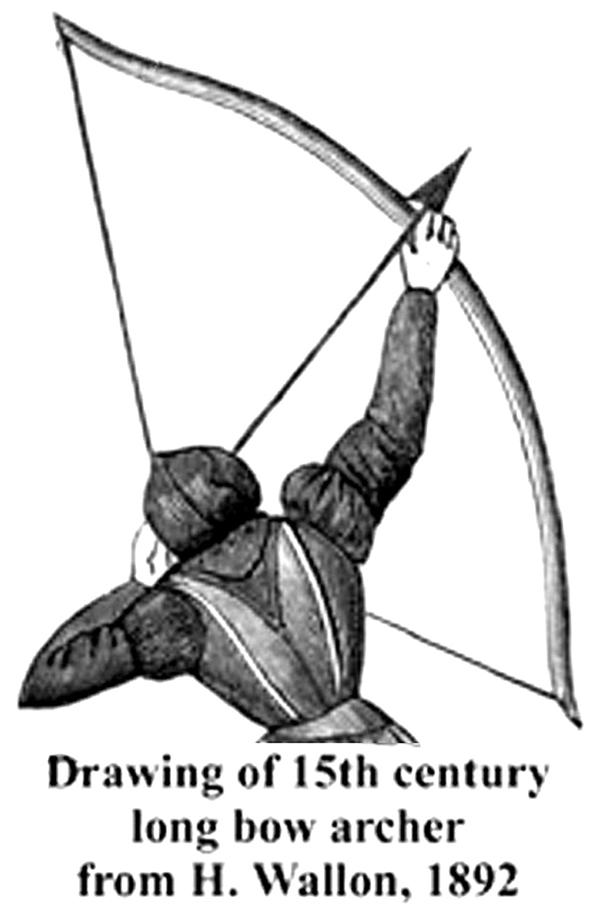
THE ENGLISH LONGBOW: In an article written for the English magazine, ORIFLAMME (issue 6 - 31st October 2000) titled THE ENGLISH LONGBOW, the English expert on the Longbow, Christopher Agius, states the following: "The longbow (itself) rarely exceeded the length of six feet." The total length of an English Longbow arrow was forty inches. The general-purpose arrowhead looked like an elongated diamond and was made from hardened steel. It was approximately two inches long by three fourths of inch wide at its widest point and slightly larger than one half inch thick at the center. It could easily penetrate armor.
To draw the arrow back to its fullest extent the bowmen had to pull on the string with the force of one hundred and twenty five pounds! Mr. Agius continues: "For the archer to be considered competent he had to be able to draw and discharge 12 well aimed arrows in a minute aiming at a target 240 yards away. A miss of even one arrow was considered a disappointing show."
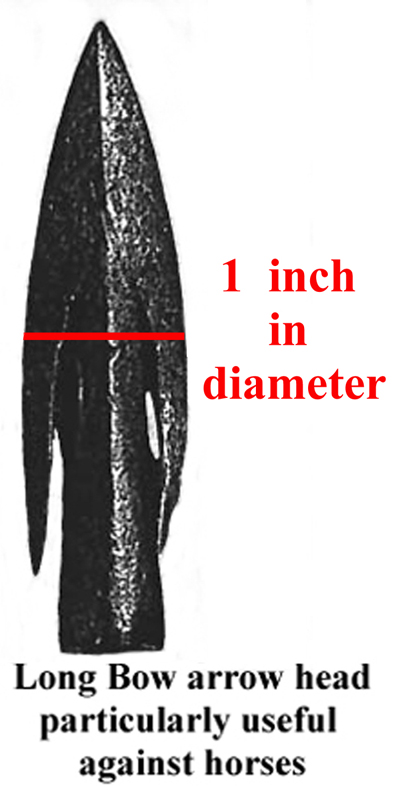


Mr. Agius asserts: "The incredible ability of the longbow's arrows to penetrate four inch thick oak doors as well as passing through BOTH of a knight's armor clad thighs, with the horse and saddle in between! The Arrows fired from a longbow could easily penetrate armor at 100 yards, kill at 200 yards and severely wound at 400 yards!
Point blank range was considered anywhere up to one hundred and forty yards away. A long flight of the arrow was up to three hundred yards and even at that distance it could penetrate chain mail and cause major injury to the body. The arrow left the bow at a speed of anywhere between one hundred and twenty-five to one hundred and fifty miles per hour and would hit the object almost as fast because only air friction would slow it down.
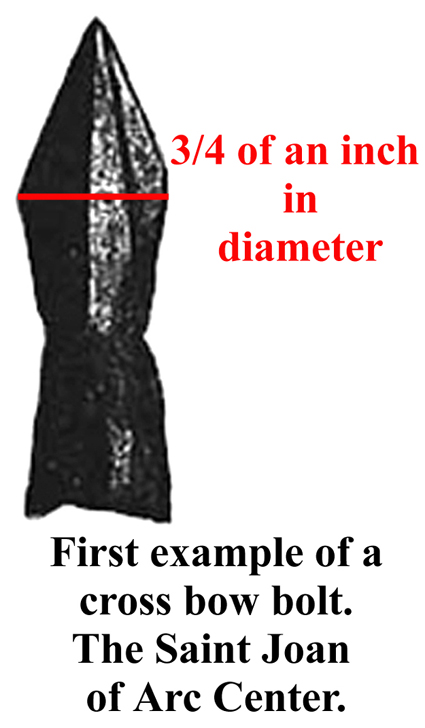
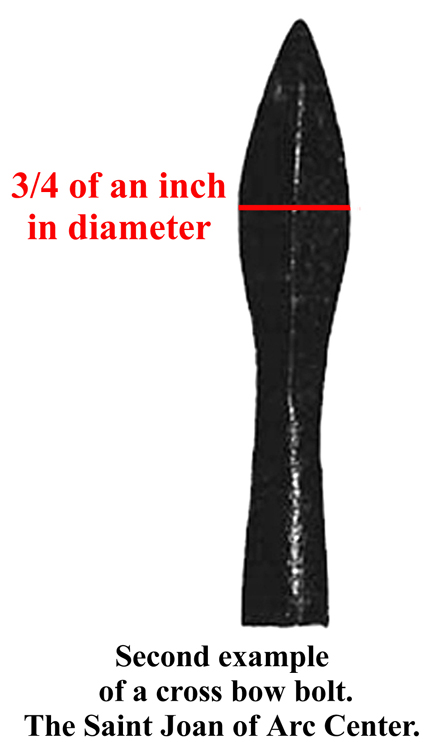
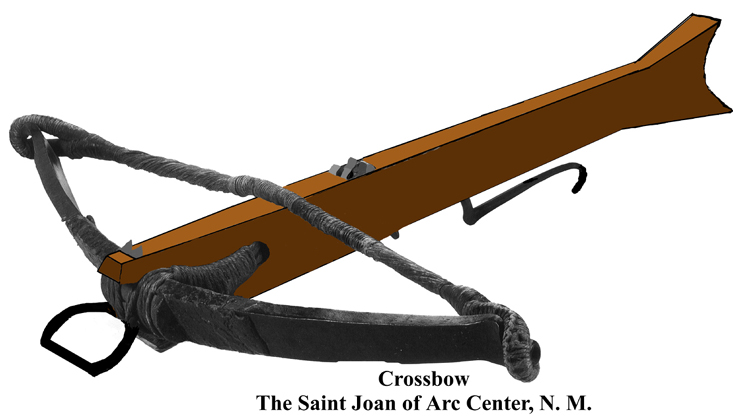
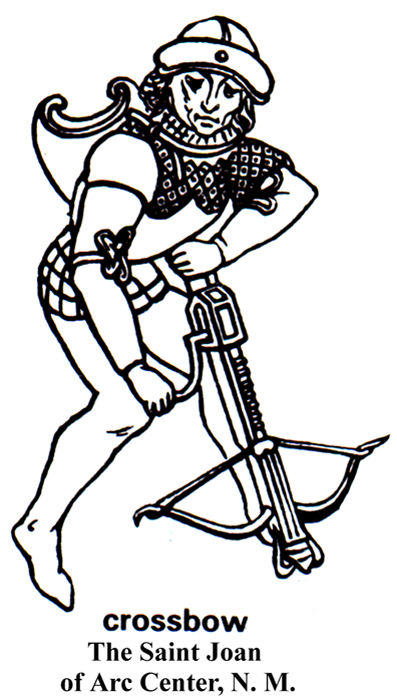
THE CROSSBOW: The bolt's total length was nine inches. The head of the crossbow bolt was made from hardened steel. In shape, the point was like a four-sided pyramid with curved sides that was approximately two inches long by nearly three-quarters to one inch wide at the widest point. A crossbow bolt would leave the bow at a speed of approximately three hundred miles per hour and could travel up to one thousand feet.
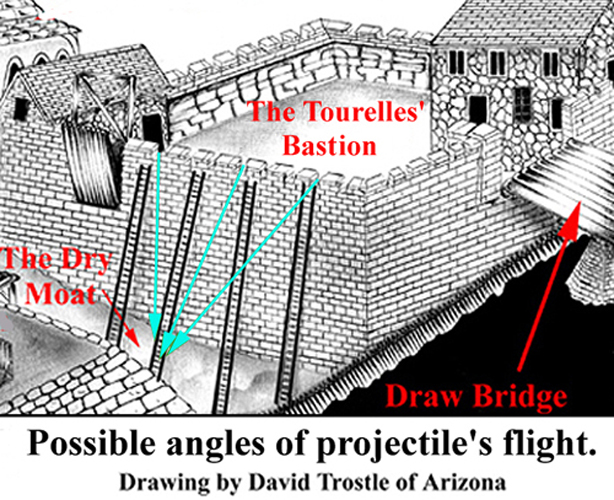
The direction of the projectile: It is important to keep in mind that the object which wounded Joan could NOT have come from ground level, that is, in front of and at the same level as Joan. Why? Simply because there were NO English soldiers standing in front of her. They were all shooting from the top of the bastion, some forty feet ABOVE her. The angle of the scaling ladder was most likely at sixty degrees, according to Mr. Lucien Harmery's model.
Differences in anatomy between a man and a woman: Compared to men, women have less muscle mass in addition woman's organs are closer together thus a greater potential for severe damage to occur in a woman.
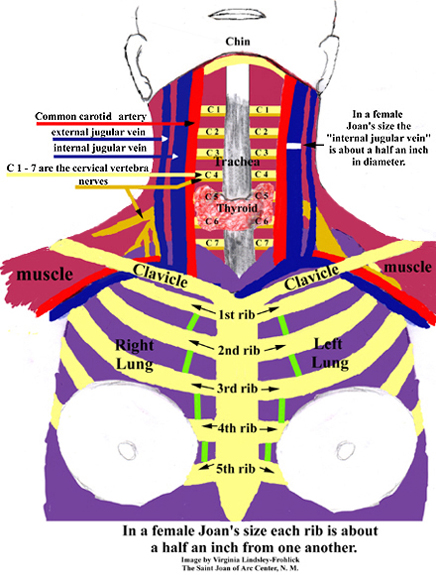
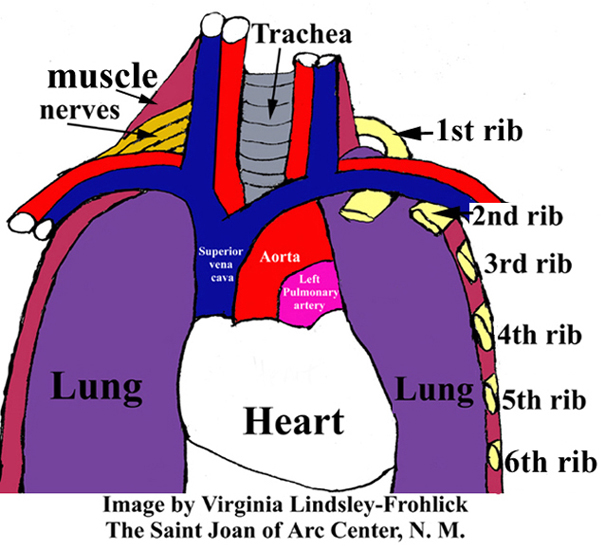 Comparative damage cause by a projectile entering the left or right side of the chest: Because the left side of the human chest has more structures in it, (i.e.), the four chambers of the heart, the aorta, the inferior and superior vena cava, the pulmonary veins and arteries, etc., there is a greater potential for a projectile to nick or lacerate one of these structures which would cause death.
Comparative damage cause by a projectile entering the left or right side of the chest: Because the left side of the human chest has more structures in it, (i.e.), the four chambers of the heart, the aorta, the inferior and superior vena cava, the pulmonary veins and arteries, etc., there is a greater potential for a projectile to nick or lacerate one of these structures which would cause death.
The three historical statements that describe her wound come from the testimonies of Joan herself, Dunois, and Father Pasquerel. JOAN: "I was wounded in the throat by a crossbow bolt." DUNOIS: "An arrow penetrated her flesh between her neck and shoulder for a depth of six inches." FATHER PASQUEREL: "She was struck... by an arrow above the breast."
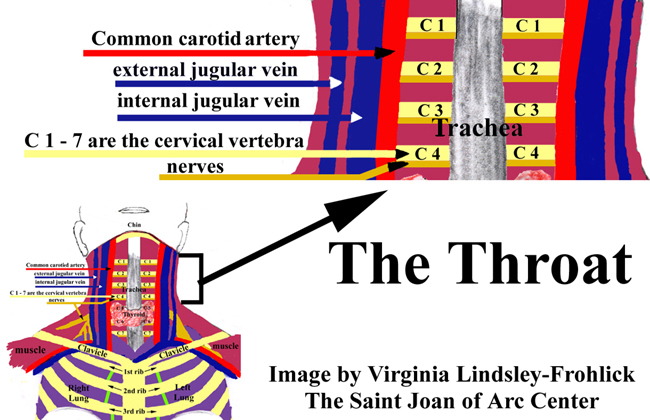
Let us examine Joan's statement first. Joan was at the bottom of the scaling ladder about to climb it, with only one foot on the bottom rung while her free hand clung to one of the upper rungs. At this point she was no more than forty to forty-five feet away from the archer. Because the arrow was shot from above, it would have struck her at an angle of somewhere between sixty and seventy degrees from the horizontal. The speed of the projectile was anywhere between one hundred to three hundred miles per hour. This force was transferred to Joan's body as it passed through the chain mail, thick doublet and her flesh.
Let us look at the damage that each of the Longbow arrowheads would have caused if they had entered Joan's throat.

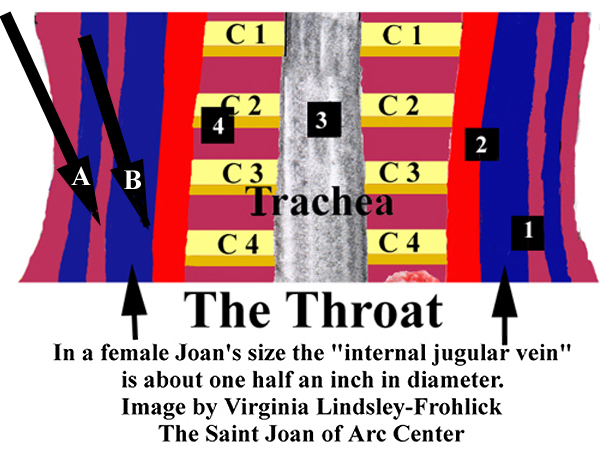
EXAMPLE 1) This arrowhead is one half inch square. (In the above diagram each of the numbered black boxes are also one half an inch square. "Arrow A" shows a sixty-degree entry and "arrow B" shows a seventy-degree entry.) An arrow of this size striking areas 1, 2 or 3 would have caused death because of the difficulty of stopping the ensuing bleeding. If the arrow had struck area 4 it would have fractured the 'vertebral spines' of the neck as well as severing the nerves it passed through causing paralysis in the affected areas.
I cannot over emphasize this one point: Joan did NOT have access to modern medical and or surgical treatment for her wound, which today allows similar injuries to be easily treated and cured.
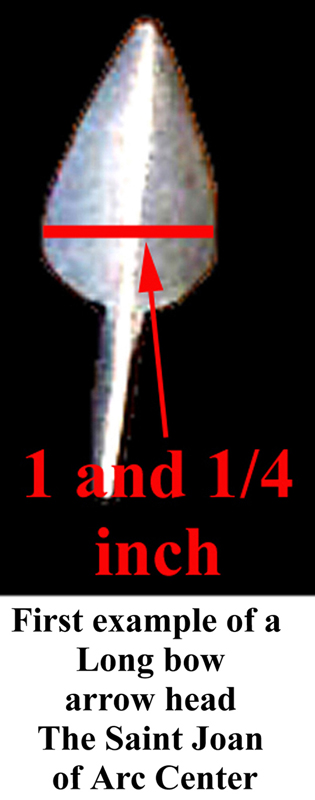
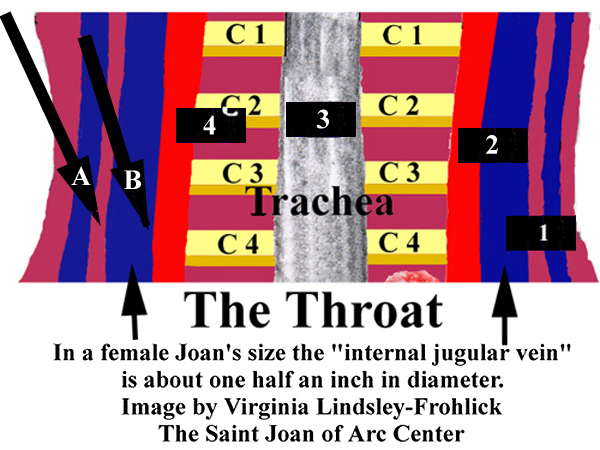
EXAMPLE 2) This arrow head is one and one forth inch wide by one half inch thick. (In the above diagram each of the numbered black boxes are also the same dimensions of the arrow. "Arrow A" shows a sixty-degree entry and "arrow B" shows a seventy-degree entry.) An arrow of this size striking areas 1, 2, 3 and 4 would have caused death because of the difficulty of stopping the ensuing bleeding.

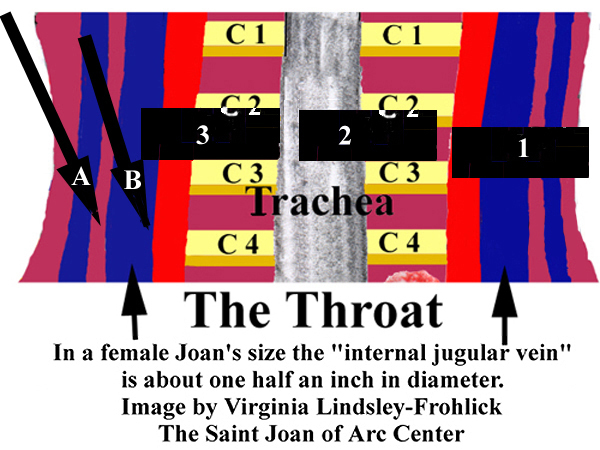
EXAMPLE 3) This arrow head is two and three forth inch wide by one inch thick. (In the above diagram each of the numbered black boxes are also the same dimensions of the arrow. "Arrow A" shows a sixty-degree entry and "arrow B" shows a seventy-degree entry.) An arrow of this size striking areas 1, 2, 3 would, with out a doubt, have caused death because of the ensuing hemorrhaging.
If either the English longbow arrow or the armor-piercing bolt had struck Joan's throat, it would have caused the total obliteration of either her right or left Carotid artery and Jugular Vein depending on which side of the neck it entered. In addition it would have cause the severe laceration of her trachea or windpipe, preventing her from obtaining enough oxygen to sustain life! In non-miraculous circumstances the person receiving a wound of this sort would hemorrhage to death within two to four minutes even with the most modern of medical techniques.
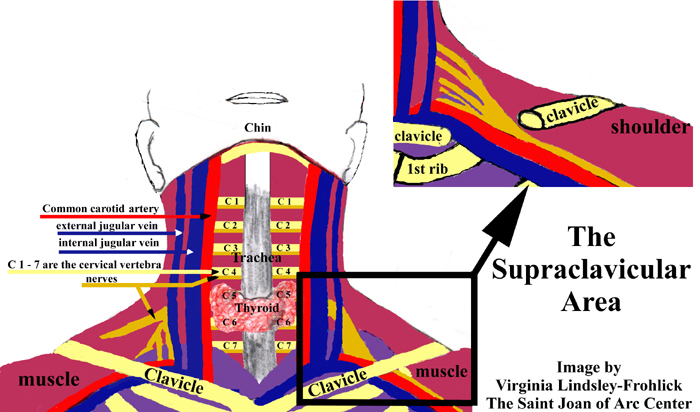
Let us examine Dunois' testimony next. "An arrow penetrated her flesh between her neck and shoulder for a depth of six inches." I interpret this to mean an arrow and its shaft entered Joan's body, penetrating into it for a distance of six inches, and did not reemerge out her back. I understand the phrase:" between her neck and shoulder" to mean the area of the body, which is called the Supraclavicular Area. This is the bilateral, triangular shaped area that transitions the neck into the shoulder.
Keep in mind that a man has a larger muscle mass than does a woman. In a man the thickness of this triangular shaped area measures three inches. Its height from the clavicle to the top of the area is two and a half inches. The length is four inches. In a female the thickness of this area measures two and a half inches. Its height from the clavicle to the top of the area is only one and a half inches, while the length is only two inches.
Several historians have interpreted "penetrating the flesh to a depth of six inches" to mean the projectile pierced through the Supraclavicular Area and the end of the projectile projected out her back for six inches. For this to happen with only the Trapezius muscle being lacerated, the projectile must have been fired in front of and perpendicular to Joan. As I have already demonstrated, this would have been impossible since the English were firing down at her from above.
There is an author who feels the projectile penetrated only her Trapezius. The projectile entered her body at the top of the Supraclavicular Area and traveled through her Trapezius muscles to exit out her back, a nasty wound but definitely not fatal. This seems plausible until you inspect the female anatomy. In women these muscles are not as massive or as thick as they are in men. This leaves very little room for a one half inch square to a two and three fourth inch wide by a one inch thick projectile to travel through just this muscle without causing damage to the surrounding bodily structures. Therefore I believe this scenario is implausible.

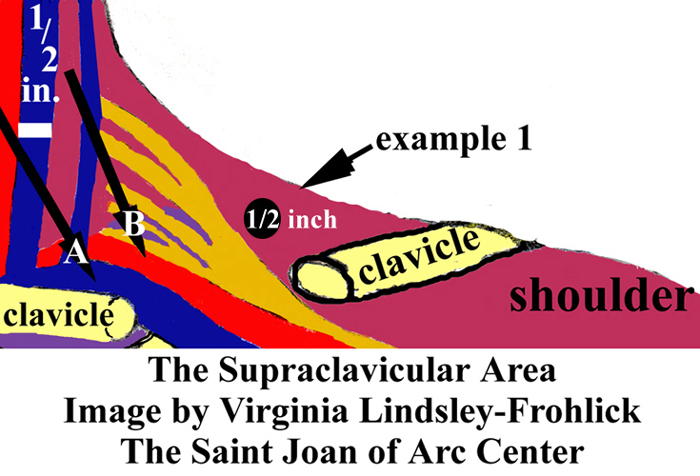
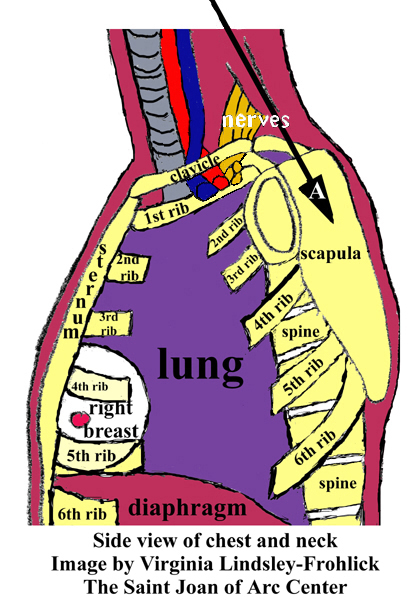
EXAMPLE 1) This arrowhead is one half inch square. (In the above diagram the marked areas is also one half an inch. "Arrow A" shows a sixty-degree entry and "arrow B" shows a seventy-degree entry.)
Let us explore the possibility that the projectile had entered the Supraclavicular Area at the angle between sixty and seventy degrees from the horizontal. What would happen to her body? First the Trapezius and Rhomboideus muscles would be lacerated. Besides fracturing her clavicle and/or first and second ribs, the projectile could also have fractured the top portion of her Scapular called the Fossa, better known as the wing bone.
There was a ninety percent chance for the projectile to penetrate and lacerate her lung. If the penetration occurred on the right side, it would cause approximately one third of her lung to collapse since there are three lobes to this lung.
Consider the lung tissue itself. As the projectile entered her body to the depth of six inches there is no possible way that the lung tissue could avoid being perforated and lacerated, this condition is called a 'pneumothorax'. If air gets into the chest cavity by entering through an abnormal hole in the chest wall, the lung tissue will collapse upon itself. The lung tissue will also collapse if blood enters the lung cavity. The collapse of the lung is life threatening as the damaged part can no longer function, thus decreasing the amount of oxygen the body can obtain from the other functioning lobes. Despite bleeding heavily from her wound, Joan did not experience any difficulty in breathing.

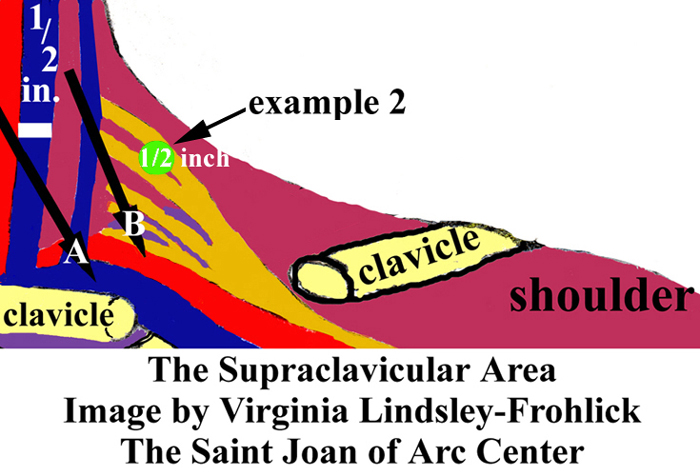
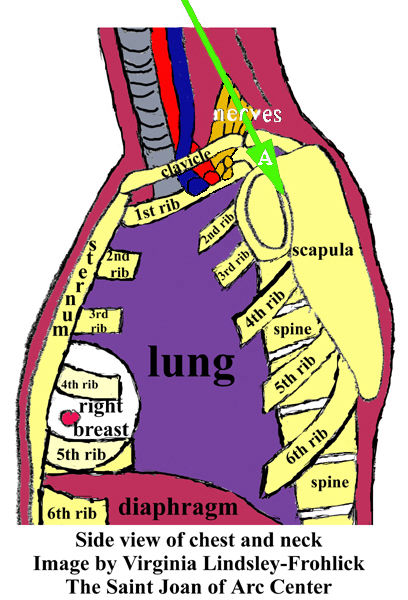
EXAMPLE 2) This arrowhead is one half inch square. (In the above diagram the marked area is also one half an inch. "Arrow A" shows a sixty-degree entry and "arrow B" shows a seventy-degree entry.)
In this example we see there was a ninety percent chance that the three major nerves that travel through this area of the body would have been lacerated or completely severed. If that had occurred, the upper portion of her chest, her shoulder and the upper part of her arm would have been paralyzed. In addition Joan would have sustained the same injuries as in example 1, namely the penetration of her lung tissues which would cause a 'pneumothorax' and the fracturing of her ribs and scapular bone. As is seen from the historical record these injuries did not occur.

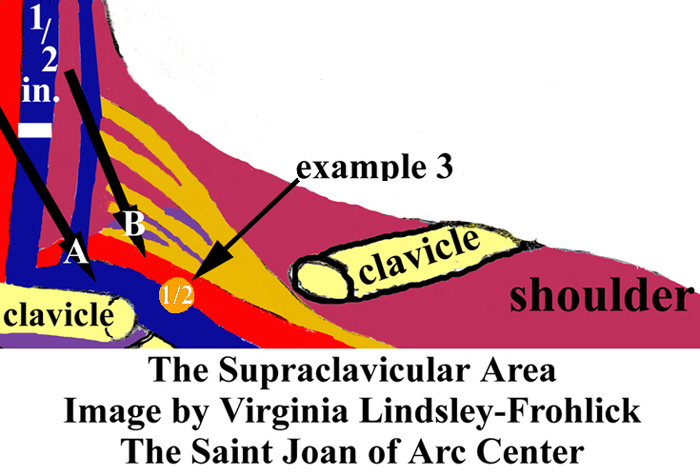
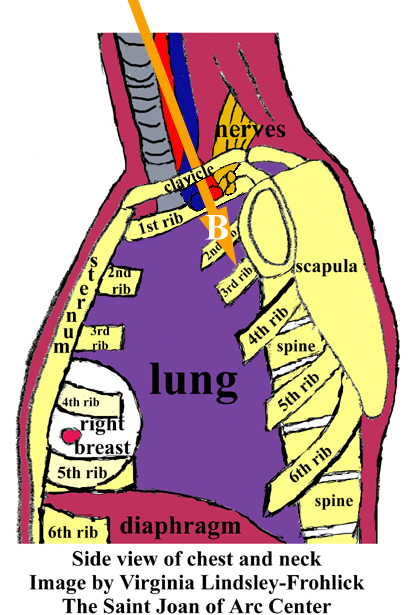
EXAMPLE 3) This arrowhead is one half inch square. (In the above diagram the marked areas is also one half an inch. "Arrow A" shows a sixty-degree entry and "arrow B" shows a seventy-degree entry.)
Since the Subclavian artery and vein are both one half inch in diameter, combined they would occupy an area of one inch by half an inch, leaving, in this example, a ninety percent chance of laceration of one or both of these blood vessels. If that had occurred, Joan would have hemorrhaged to death in five minutes. In addition to this catastrophic injury Joan would have sustained the same injuries as in the first two examples, namely the penetration of her lung tissues and the fracturing of her ribs.
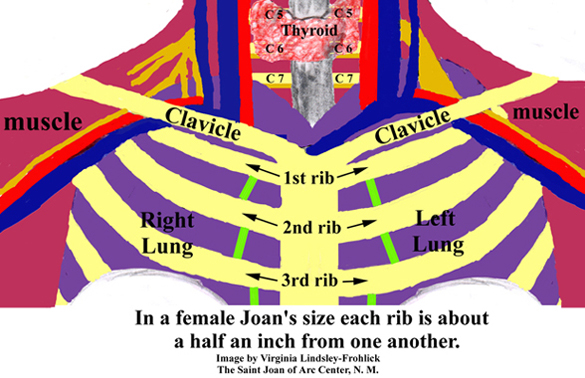
Finally let us examine Father Pasquerel's version, "She was struck... by an arrow above the breast." This statement implied that the arrow entered BELOW the clavicle while Dunois' statement implies that the arrow entered ABOVE the clavicle. Before the advent of modern vascular surgery, an arrow entering the body, in an area below the bone called the clavicle, would have had a ninety- percent chance of causing a fatal wound. This would be caused by the damage done to the major blood vessels and to the lung tissues that are located there.
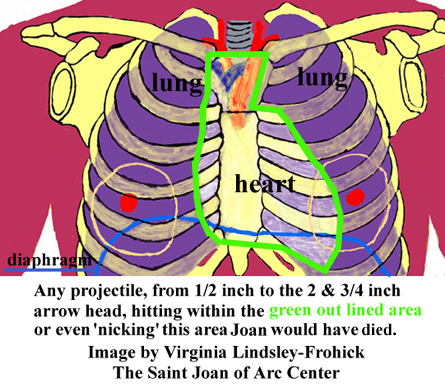
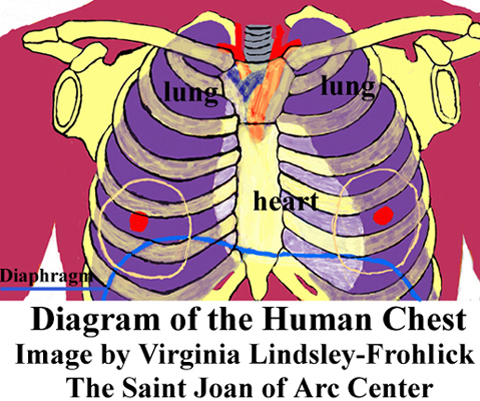
The projectile would pass through her pectoralis muscle, punching out the muscle tissue equal to its area. The radiating damage of severely bruised and bleeding muscle tissue would extend for an additional one inch around the arrowhead. If the projectile had entered either side of her chest from above, it could cause major damage by fracturing of the first, second and/or third rib. It could perforate the Subclavian artery and vein which are the major blood vessels supplying blood to the lung, upper chest and right arm. No matter what size projectile, from the 1/2 inch to the 2 & 3/4-inch arrowhead, penetrating inside the marked green area of the first diagram would have caused Joan's death within a very short time. The penetration of Joan's lung tissue on either side of her chest would have caused a medical condition called 'pneumothorax'. This condition occurs when air enters the lung sack through an abnormal hole in the chest wall. With the collapse of the lung tissue it can no longer function to oxygenate the blood, thus causing the person to suffocate. Because in Joan's time the doctors did not have the ability of stopping most types of internal bleeding the build up of blood in Joan's lung sack would have caused the remaining lobes of the affected lung to collapse. This medical condition is called 'hemothorax.' Left untreated both these conditions - pneumothorax and hemothorax - would have caused Joan to die from suffocation or the lack of oxygen in her blood.
In summary: No matter which scenario was true, the wound she sustained was life threatening. She would have had fractures to her clavicle, first and second ribs and the Fossa of the Scapula, a fatal hemorrhage, the paralysis of her shoulder and arm, and/or a collapsed lung. However, the testimony of the eyewitnesses say the day Joan received the wound she returned to her work after only one or two hours of rest! The next day, Joan dressed in a light coat of chain mail. Other than this concession to her wound she did not stop riding, wearing armor or doing the work that God gave her! Thus I believe it was the Hand of God that sustained and protected her from the consequences of her wound!
Mr. Paul Harker of Los Angeles, California, holds a BS degree in Medieval Warfare and a Masters in Medieval Society/History. He has assisted on archaeological excavations in England, Ireland, Scotland, France, Italy and Syria. In addition he is one of the chief historians at
http://www.MedievalOnline.com, which is an American web site. Here he assists authors, filmmakers and documentarians with Middle Ages research. His current work on the strategies and tactics employed by Joan of Arc will be applied toward a historical investigation led by a Canadian based professional research panel.In regards to my above statements, Mr. Harker states:
"Having read your paper regarding Joan's injuries, I find your thoughts to be well founded and the presentation well written. From my position as a certified historian, I must politely contest your paper while in no manner denying the possibility of miraculous intervention."
"There is a documented case of American Pvt. William J. Gregory. During the Second World War, Pvt. Gregory was taken prisoner by the Germans in the Ardennes and machine gunned at near pointblank range. Pvt. Gregory not only survived 14 bullet wounds to the chest, legs and face, but also managed to crawl back to his unit where he was treated. Pvt. Gregory recovered and lived to the age of 74."
On the surface, this extraordinary example of survival appears impressive, but looking at the details we see that Pvt. Gregory was able to crawl back to his unit WHERE HE WAS TREATED.
As a medical professional the word "treated" indicates that Pvt. Gregory was taken into surgery were the 14 machine-gun bullets were removed and the internal and external lacerations caused by these bullets were repaired and sutured closed. In addition the body fluids he would have lost had to be replaced by the use of one or more intravenous fluid replacement lines. If Pvt. Gregory had not received these modern medical and surgical treatments he would NOT have survived.
Joan, on the other hand, did NOT have access to modern medical and or surgical treatment for her wound, which today allows similar injuries to be easily treated and cured.
The second miraculous incident occurred during the battle for Jargeau. Joan was just starting to climb the scaling ladder that was placed against the town's wall when a stone was hurled down from its heights. The heavy stone struck with such force that it shattered upon impact against her light steel helmet and she fell stunned to the ground. The eyewitnesses thought the blow had crushed her. After only a moment or two, Joan was back on her feet climbing the ladder as if nothing had happened, all the while vigorously cheering her men on to victory.
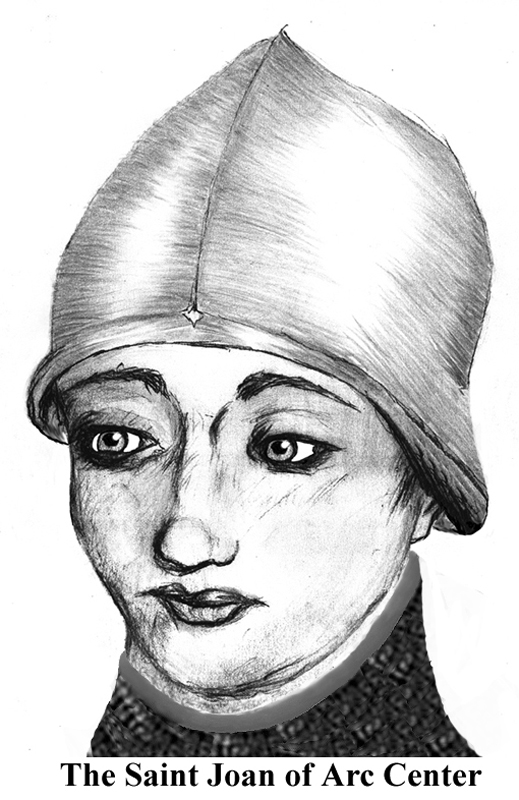
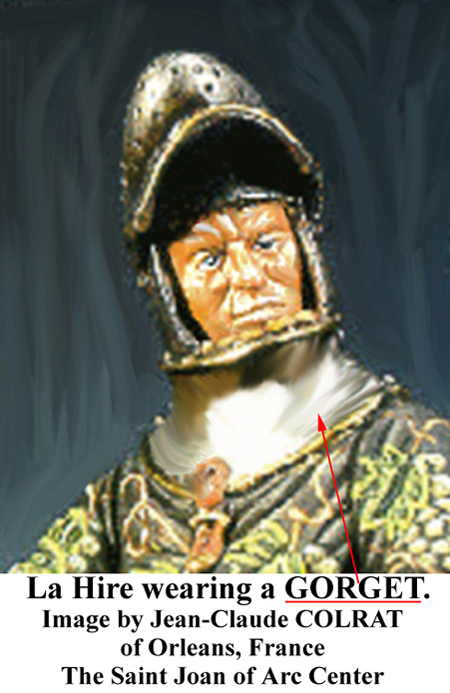
The helmet she wore looked like a skullcap, without visor or gorget. A gorget was the armor plate that was worn around the chin and neck. The force necessary to shatter a heavy stone could easily have crushed her skull or at the very least fractured her skull and caused a brain contusion or bleeding within the skull. Because the skull is an enclosed space, any amount of bleeding can cause brain damage, which could lead to paralysis or even death.
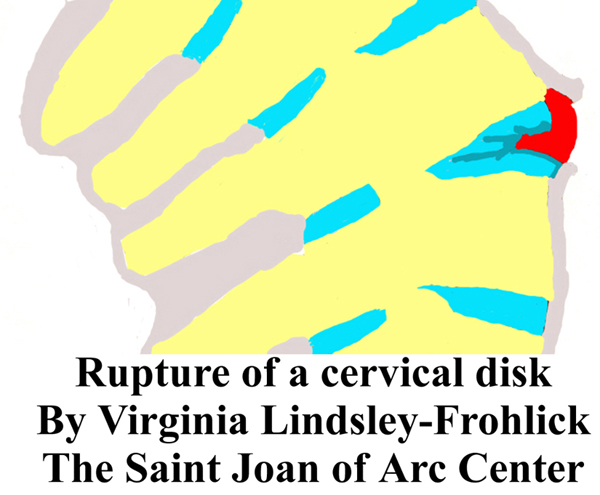
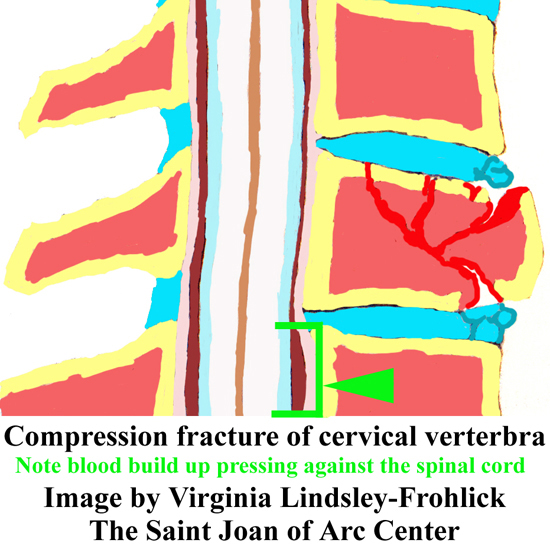
If worn, the gorget could easily transfer the force of the blow to the shoulders and chest, thus helping to protect the neck from injury. Since Joan did not use one, the force was transferred directly to her neck, and could easily have caused at the very least a rupture of one or more of her cervical disks. In addition this blow to her head could easily have fractured her cervical vertebrae, in other words a broken neck, which, if not fatal, would cause paralysis of her body from the neck down. Note in the second medical diagram how there is a build up of blood below the fracture. This pressure if not released would cause partial to total paralysis. Yet Joan was only stunned for a moment.
The third occurrence happened in the attack on Paris. In this battle a crossbow bolt pierced her thigh. (See my earlier description of the crossbow.) As previously described, the bolt from a crossbow can travel up to one thousand feet! Joan was about one hundred and ten feet from the archer when she was hit.



According to the Burgundian chronicler Bourgeois of Paris, Joan's leg was transpierced. Trans, which means to go through and the word pierce means to cut or pass through with a sharp instrument. Therefore the chronicler was saying that the bolt went through Joan's thigh! The bolt had to pierce the cuissard or thigh plate and her padded hose. As it entered her flesh, it could have easily struck her thighbone (femur.)
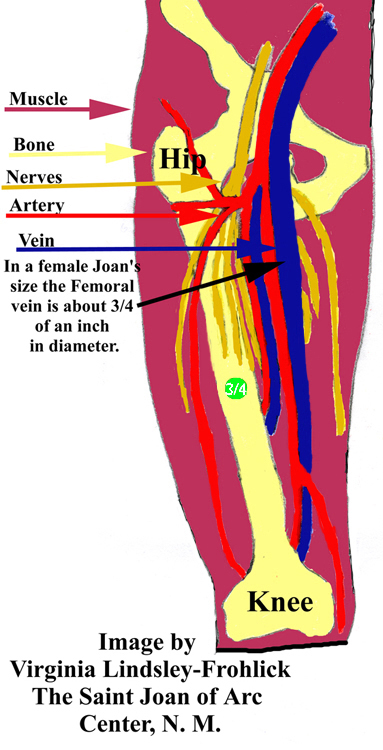
Example 1) In this diagram we see a 3/4 inch diameter projectile penetrating Joan's femur. The force of this impact would have shattered this bone. An infection would occur within a few days causing a gangrenous condition. Before the discovery of antibiotics the only treatment for 'gangrene' was amputation of the limb. At best she would have been left permanently disabled.
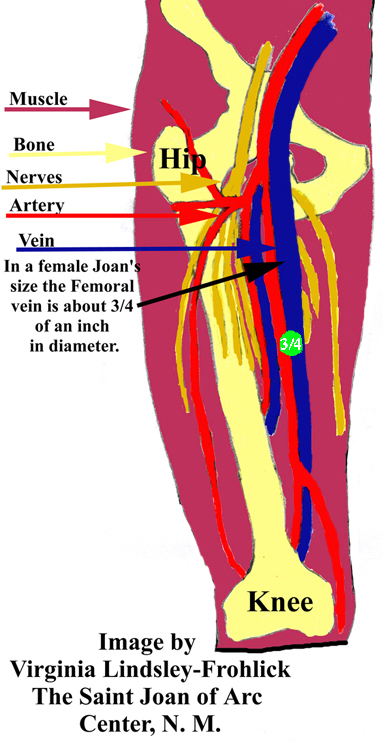
Example 2) In this diagram we see a 3/4 inch diameter projectile penetrating Joan's femoral vein and artery. Had this occurred Joan would have hemorrhaged to death within a short period of time.
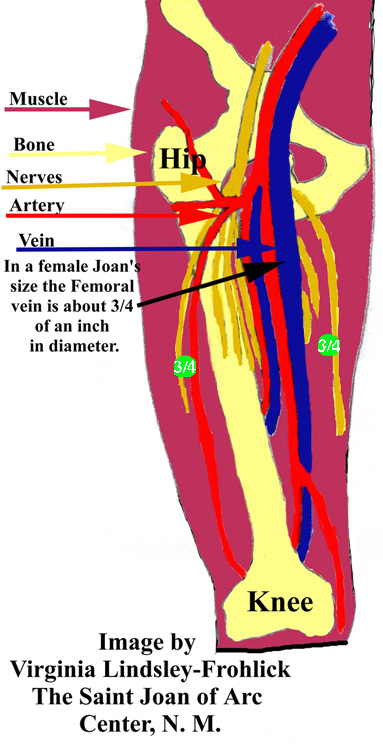
Example 3) In this diagram, I have created TWO different 3/4 inch diameter areas showing possible projectile penetration points. The site on the right shows one of the many nerves that branch off the 'sciatic nerve'. If this nerve were severed it would cause a decrease in the ability to control the legs movement. If the penetration site occurred on the left side it would not only cause a loss of leg control but severe bleeding as well. At the very least either of these two injuries could lead to a serious infection, called sepsis. The bolts used at the time were not clean when they were fired. Joan could have easily died a slow and very painful death from the ensuing infection.
The fourth and final example of God's protection happened when Joan jumped from the Beaurevoir Tower. This tower was approximately 60 to 80 feet in height. The guards found her unconscious on the rocky ground. Because she was unconscious for a time, the historians believe, rightly, that she must have sustained a concussion. Yet the evidence shows that she sustained NO OTHER INJURIES and was completely well within a few days.
Many people who jumped from far lesser heights have been killed and those who survived the fall have suffered crippling injuries. For example a fall from a height of one story could cause a broken foot, leg, arm or pelvis.
Using the calculus equation of: V= SQRT(2gs); where, g = 32.2 ft/sec/sec and S = distance = 80 ft. V= SQRT (2*32*80), V= 71.5ft/sec. 88 ft/sec is equivalent to 60 mi./hr.
88 / 60 = 71.5/x so x = 48.75 mi./hr. If we use 60 ft instead of 80 ft, we arrive at an approximate speed of 42 miles per hour when her body hit the ground. What damage could that have caused? Quite a bit! Surely God's protective hand was upon her.
In regards to my above statement, Mr. Harker replies:
"Furthermore, in relation to the Beaurevoir Tower, there are well-documented cases of paratroopers with chute-failure who fell far greater distances only to hit the ground and survive."
Again on the surface his statement rings true. I agree with Mr. Harker, that I too have heard reports of people hitting the ground after their chutes failed to open. But in the cases that I know of, these lucky few had fallen onto either freshly plowed fields, muddy fields or onto freshly aerated lawns. In each of these cases the ground was sufficiently 'softened' to absorb some of the gravitational forces that were exerted against the victims body. Even so these people were immediately taken to the closest hospital where their internal injuries were determined and surgically treated. In Joan's case her body hit HARD, ROCKY GROUND, even so the doctor who was called to examine her found no broken bones or any signs of internal injuries, such as bleeding from the nose, mouth or ears.
In conclusion Mr. Harker states: "I have a broad understanding of medieval warfare being that it is my area of expertise. My admission is that the wounds sustained in such venues of combat were hideous. My conscience tends to lean toward the miraculous intervention of God, but I hope you understand that I must dismiss enough factual data to reach that conclusion…. In fact, your opinions are quite a fresh approach to the subject. It is my own personal conflict of addressing facts and hard data that must be resolved. …please understand that my comments regarding your paper are mere opinions and in no way do I intend a negative overview of what you have written. I find your comments to be very well formed and highly intellectual."